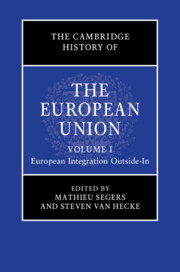Book contents
- The Cambridge History of the European Union
- The Cambridge History of the European Union
- The Cambridge History of the European Union
- Copyright page
- Contents
- Figures
- Contributors to Volume I
- Acknowledgements
- Abbreviations
- Reflections on the History and Historiography of European Integration
- Part I Critical Junctures
- Part II Multilateralism and Geopolitics
- Market, Society and Security
- Global Challenges: International Politics, the Planet and the Universe
- 13 European Integration and the United Nations
- 14 The European Nuclear Dimension: From Cold War to Post-Cold War
- 15 From ‘Helsinki’ and Development Aid to Multipolar Hard Ball
- 16 European Integration, the Environment and Climate Change
- 17 The Space Policy of the European Union
- Part III Perspectives and Ideas
- Index
- References
17 - The Space Policy of the European Union
from Global Challenges: International Politics, the Planet and the Universe
Published online by Cambridge University Press: 21 October 2023
- The Cambridge History of the European Union
- The Cambridge History of the European Union
- The Cambridge History of the European Union
- Copyright page
- Contents
- Figures
- Contributors to Volume I
- Acknowledgements
- Abbreviations
- Reflections on the History and Historiography of European Integration
- Part I Critical Junctures
- Part II Multilateralism and Geopolitics
- Market, Society and Security
- Global Challenges: International Politics, the Planet and the Universe
- 13 European Integration and the United Nations
- 14 The European Nuclear Dimension: From Cold War to Post-Cold War
- 15 From ‘Helsinki’ and Development Aid to Multipolar Hard Ball
- 16 European Integration, the Environment and Climate Change
- 17 The Space Policy of the European Union
- Part III Perspectives and Ideas
- Index
- References
Summary
The European Union’s (EU’s) space policy (EUSP) is one of the more interesting EU policy areas, even though it is one of the newer and lesser known ones. Officially, there is no EUSP, but rather a European Space Policy (ESP). Space became one of the EU’s competence areas in 2009, when the Treaty on the Functioning of the EU (TFEU), also known as the Lisbon Treaty, was ratified. Satellite navigation and positioning have security dimensions and it is odd, to say the least, that the EU owns Galileo, a Global Navigation Satellite System (GNSS) comparable to the better-known Global Positioning System (GPS) owned by the US government.
- Type
- Chapter
- Information
- The Cambridge History of the European Union , pp. 442 - 468Publisher: Cambridge University PressPrint publication year: 2023

